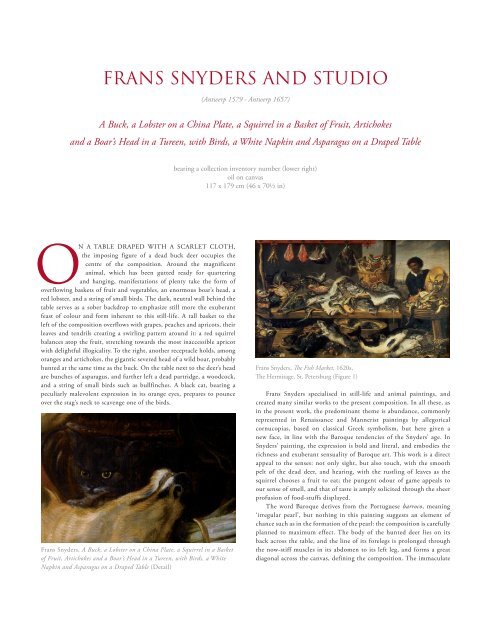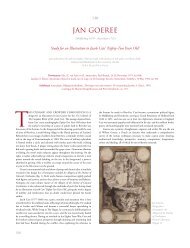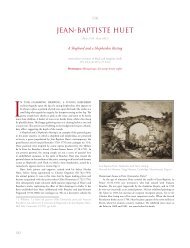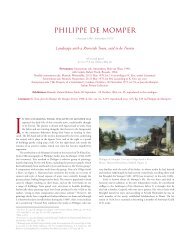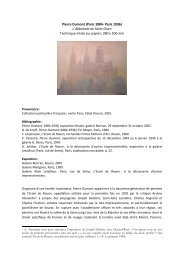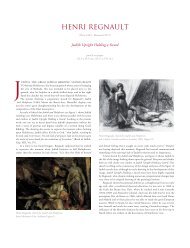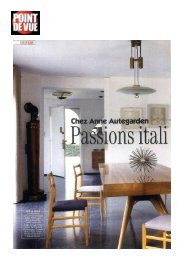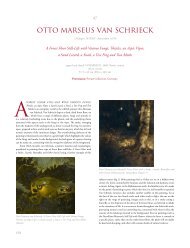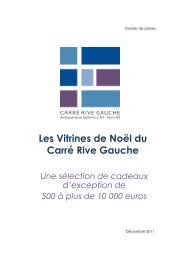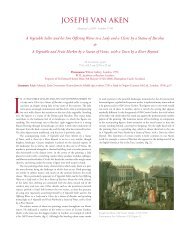Frans snyders, A Buck, a Lobster
Frans snyders, A Buck, a Lobster
Frans snyders, A Buck, a Lobster
Create successful ePaper yourself
Turn your PDF publications into a flip-book with our unique Google optimized e-Paper software.
<strong>Frans</strong> Snyders and Studio<br />
on a table draped with a scarlet cloth,<br />
the imposing figure of a dead buck deer occupies the<br />
centre of the composition. around the magnificent<br />
animal, which has been gutted ready for quartering<br />
and hanging, manifestations of plenty take the form of<br />
overflowing baskets of fruit and vegetables, an enormous boar’s head, a<br />
red lobster, and a string of small birds. the dark, neutral wall behind the<br />
table serves as a sober backdrop to emphasize still more the exuberant<br />
feast of colour and form inherent to this still-life. a tall basket to the<br />
left of the composition overflows with grapes, peaches and apricots, their<br />
leaves and tendrils creating a swirling pattern around it: a red squirrel<br />
balances atop the fruit, stretching towards the most inaccessible apricot<br />
with delightful illogicality. to the right, another receptacle holds, among<br />
oranges and artichokes, the gigantic severed head of a wild boar, probably<br />
hunted at the same time as the buck. on the table next to the deer’s head<br />
are bunches of asparagus, and further left a dead partridge, a woodcock,<br />
and a string of small birds such as bullfinches. a black cat, bearing a<br />
peculiarly malevolent expression in its orange eyes, prepares to pounce<br />
over the stag’s neck to scavenge one of the birds.<br />
(Antwerp 1579 - Antwerp 1657)<br />
A <strong>Buck</strong>, a <strong>Lobster</strong> on a China Plate, a Squirrel in a Basket of Fruit, Artichokes<br />
and a Boar’s Head in a Tureen, with Birds, a White Napkin and Asparagus on a Draped Table<br />
<strong>Frans</strong> <strong>snyders</strong>, A <strong>Buck</strong>, a <strong>Lobster</strong> on a China Plate, a Squirrel in a Basket<br />
of Fruit, Artichokes and a Boar’s Head in a Tureen, with Birds, a White<br />
Napkin and Asparagus on a Draped Table (detail)<br />
bearing a collection inventory number (lower right)<br />
oil on canvas<br />
117 x 179 cm (46 x 70½ in)<br />
<strong>Frans</strong> <strong>snyders</strong>, The Fish Market, 1620s,<br />
The hermitage, st. petersburg (Figure 1)<br />
<strong>Frans</strong> <strong>snyders</strong> specialised in still-life and animal paintings, and<br />
created many similar works to the present composition. in all these, as<br />
in the present work, the predominant theme is abundance, commonly<br />
represented in renaissance and Mannerist paintings by allegorical<br />
cornucopias, based on classical Greek symbolism, but here given a<br />
new face, in line with the baroque tendencies of the <strong>snyders</strong>’ age. in<br />
<strong>snyders</strong>’ painting, the expression is bold and literal, and embodies the<br />
richness and exuberant sensuality of baroque art. this work is a direct<br />
appeal to the senses: not only sight, but also touch, with the smooth<br />
pelt of the dead deer, and hearing, with the rustling of leaves as the<br />
squirrel chooses a fruit to eat; the pungent odour of game appeals to<br />
our sense of smell, and that of taste is amply solicited through the sheer<br />
profusion of food-stuffs displayed.<br />
the word baroque derives from the portuguese barroco, meaning<br />
‘irregular pearl’, but nothing in this painting suggests an element of<br />
chance such as in the formation of the pearl: the composition is carefully<br />
planned to maximum effect. the body of the hunted deer lies on its<br />
back across the table, and the line of its forelegs is prolonged through<br />
the now-stiff muscles in its abdomen to its left leg, and forms a great<br />
diagonal across the canvas, defining the composition. the immaculate
<strong>Frans</strong> <strong>snyders</strong>, A <strong>Buck</strong>, a <strong>Lobster</strong> on a China Plate, a Squirrel in a Basket<br />
of Fruit, Artichokes and a Boar’s Head in a Tureen, with Birds, a White<br />
Napkin and Asparagus on a Draped Table (X-ray, detail, Figure 2)<br />
white napkin negligently thrown on the table acts as a repoussoir for<br />
the baskets piled high behind the buck, breaks the monotony of the<br />
red table-cloth and thus stabilises the composition. the immense heaps<br />
of food-stuffs are consistent with the pyramidal forms, indicating<br />
abundance, favoured by <strong>snyders</strong> in many of his compositions, such as<br />
Fruit Piece with a Squirrel and a Cat, (c.1630-1650, cologne, wallrafrichartz<br />
Museum). this latter piece is an example of one of <strong>snyders</strong>’<br />
later compositions that still retains the relative simplicity of his earlier,<br />
smaller works. indeed, as from 1620 approximately, <strong>snyders</strong>, who<br />
was already a well-established and highly-regarded artist, produced<br />
a large number of truly monumental compositions, for instance the<br />
hermitage's four huge Markets of 1618-1621, see figure 1, or the Larder<br />
of circa 1640 (caen, France, Musée des beaux-arts).<br />
in comparison to peter paul rubens (1577-1640), whom <strong>snyders</strong><br />
may have met either in italy or antwerp, an englishman, toby<br />
Matthew, wrote about <strong>snyders</strong>’ talent at portraying animals in a letter<br />
to his patron sir dudley carterton regarding a painting of a hunt by<br />
rubens: “in this peece the beasts are all alive, and in act eyther of<br />
escape or resistance, in the expressing whereof snyder doth infinitelie<br />
come short of rubens [...]. the talent of <strong>snyders</strong> is to represent<br />
beasts but especiallie birds altogether dead, and wholly without anie<br />
action”.¹ <strong>snyders</strong>’ skill in this area is yet again proved in this painting:<br />
if one compares the treatment of the live cat for instance, to that of<br />
the dead partridge in the foreground, one realises the difference in<br />
¹ From a letter dated February 25, 1617, quoted in Koslow, s., <strong>Frans</strong> Snyders,<br />
(brussels, Fonds Mercator, 2006), p. 18<br />
<strong>Frans</strong> <strong>snyders</strong>, Pantry Scene with a Page, c.1612,<br />
wallace collection, london (detail, Figure 2)<br />
quality between those two depictions: the cat, although its glinting<br />
orange eyes are very realistic and impart a look of concentration and<br />
longing as the animal eyes up its prey, is far less anatomically correct<br />
than the game-bird; the dead partridge’s delicate plumage and form<br />
are admirably rendered by <strong>snyders</strong> and his studio in a very detailed<br />
depiction, based on close observation of his subject, even to the whitish<br />
lower lid covering its eye. this knowledge of nature and anatomical<br />
precision are typical of <strong>snyders</strong>’ work. Matthew’s judgement regarding<br />
<strong>snyders</strong>’ alleged ineptitude at portraying living creatures can however<br />
be disproved by the large numbers of hunting canvases produced by the<br />
artist for the royal courts of europe, which were an essential part of his<br />
oeuvre and a major source of his lasting fame.<br />
a recent X-ray examination of the present painting revealed the<br />
ghost of a figure standing to the left of the table,see figure 2, identical<br />
to that of a page-boy in <strong>snyders</strong>’ Pantry Scene with a Page (c.1612,<br />
the wallace collection, london, fig. 3). it has been suggested that the<br />
figure was never finished, and was thus covered over before the painting<br />
was sold. this element can serve as an indication of date, and would set<br />
the present work among <strong>snyders</strong>’ earlier oeuvre. Moreover, the scale of<br />
this painting is more akin to the artist’s first compositions than to the<br />
monumental works he executed from the 1620s onwards.<br />
in addition to the canvas in the wallace collection, this painting<br />
stands comparison to numerous other examples of <strong>snyders</strong>’ oeuvre.<br />
<strong>snyders</strong> indeed specialised in still-life and animal painting and this
work can be seen as a typical example of his favourite subject-matter. in<br />
1609, soon after <strong>snyders</strong>’ return from italy, rubens commissioned him<br />
to paint the still-life motifs in the Recognition of Philopoemen (Madrid,<br />
Museo del prado); this was the first kitchen-market piece to have a<br />
baroque format. the composition and preliminary sketch are clearly<br />
rubens’ work, but the resulting canvas helps to define <strong>snyders</strong>’ later<br />
oeuvre and pave the way for the acceptance of the still-life genre as<br />
a high form of art. the work is characterised by a dark tonality and<br />
dramatic lighting, typical of the caravagesque tradition. a remnant<br />
of these features is visible within the present still-life: the surfaces<br />
are firmly modelled, the overall tonality is quite shadowy, and strong<br />
contrasts are formed for instance by the white napkin on the table or<br />
the strong bright form of the buck on the dark wall behind. however, a<br />
certain finesse in nuance, a brighter use of colour foretell the luminosity<br />
of some of <strong>snyders</strong>’ later works such as the Dresden Larder with a Bitch<br />
and her Pups (c.1620-1630, dresden, staatliche Kustsammlungen,<br />
Gemäldegalerie). <strong>snyders</strong>’ earliest dated still-life, Larder with Small<br />
Game, Produce and a Dove Taking Flight (1612, new York, Jack Kilgore<br />
& co., inc.), demonstrates early in the artist’s career the same skill at<br />
portraying dead birds as in the present work.<br />
<strong>Frans</strong> <strong>snyders</strong> was born in antwerp and baptized on november 11,<br />
1579. his parents, inn-keepers by profession, sent him when he was<br />
fourteen to study as an apprentice with the celebrated painter pieter<br />
brueghel the Younger (c.1564- c.1638). however, the master’s work<br />
and the time <strong>snyders</strong> spent under his tutelage had far less impact on his<br />
future oeuvre than that of Jan brueghel the elder (1568-1625), pieter’s<br />
younger brother, who returned to antwerp in october 1596 after a<br />
long sojourn in italy. nicknamed “Flower” or “Velvet” brueghel, he<br />
was best known for floral pieces, biblical canvases and landscapes, but<br />
also practised still-life and animal painting, and may have encouraged<br />
<strong>snyders</strong> to specialize in these two genres. <strong>snyders</strong> also studied in all<br />
probability under hendrick van balen (1575-1632), but again proved<br />
himself impervious to his master’s artistic influence. in 1602, at the age<br />
of twenty-three, he became a free-master in the Guild of st. luke in<br />
antwerp. a large gap in the archives in antwerp suggests that, although<br />
he is only documented as such in 1608, <strong>snyders</strong> may have travelled to<br />
italy as early as 1603. his sojourn there remains largely mysterious,<br />
the only definitive documents attesting to the places he visited and<br />
his artistic activity are the letters of Jan brueghel recommending him<br />
<strong>Frans</strong> <strong>snyders</strong>, A <strong>Buck</strong>, a <strong>Lobster</strong> on a China Plate, a Squirrel in a Basket<br />
of Fruit, Artichokes and a Boar’s Head in a Tureen, with Birds, a White<br />
Napkin and Asparagus on a Draped Table (detail)<br />
<strong>Frans</strong> <strong>snyders</strong>, Recognition of Philopoemen<br />
Museo del prado, Madrid (Figure 2)<br />
to various patrons including Federico borromeo, cardinal of Milan.<br />
in 1609, <strong>snyders</strong> left Milan rather abruptly and returned to antwerp,<br />
where he set up a studio. in 1611, he married Margriete de Vos, the<br />
sister of cornelis (1585-1651) and paul de Vos (1595-1678), renowned<br />
painters in antwerp. <strong>snyders</strong> took on only three apprentices during his<br />
lengthy career, presumably because his extended family provided him<br />
with the skill he needed to run a high-quality studio. <strong>snyders</strong>’ first<br />
dated fruit piece was executed in 1611, but it is possible that he started<br />
creating such works during his stay in italy. by the 1620s, <strong>snyders</strong><br />
had acquired a large fortune and established himself as the preeminent<br />
master of still-life painting in antwerp. in 1621, he commissioned the<br />
young anthony Van dyck (1599-1641) to paint portraits of himself and<br />
his wife (new York, Frick collection); the portraits bear testimony to<br />
<strong>snyders</strong>’ high social standing, and make no reference to his profession,<br />
which was a manual trade. in June 1619, <strong>snyders</strong> was elected a member<br />
of the confraternity of the romanists, and served as dean in 1628.<br />
this membership was a symbol of his growing social importance in<br />
antwerp.<br />
<strong>snyders</strong>’ influence on still-life and animal painting is vastly<br />
important. still-life painters belonged in <strong>snyders</strong>’ time to the third<br />
category of artists, according to a classification based on aristotle’s<br />
concept of the soul, and were considered by many as “only common<br />
foot soldiers in the army of art”,² hence the reluctance of <strong>snyders</strong>’ early<br />
biographers to acknowledge the artist’s work in this area: <strong>snyders</strong> was<br />
described as an animal painter, but his immense talent to portray inert<br />
objects was very much overlooked. however, by the time of <strong>snyders</strong>’<br />
death in 1657, still-lifes were becoming a newly sought-after genre in<br />
the courts and grand houses of europe.<br />
<strong>Frans</strong> <strong>snyders</strong> built up throughout his career a wealthy, politically<br />
influential clientele throughout the netherlands, spain and england.<br />
like rubens, he benefitted from the renewal of antwerp’s economy<br />
sparked by the twelve Years truce (1609-1621), and contributed to the<br />
city’s fame and grandeur. these dates correspond with the emergence<br />
of the larder type of still-life, of which the present work is an example:<br />
these paintings reflect the general optimism of the time, through an<br />
abundance of victuals only possible in peacetime.<br />
we are grateful to Mr Fred Meijer of the rKd for confirming the<br />
attribution on examining the work in person.<br />
² hoogstraten, s. van, Inleyding tot de Hooge Schoole der Schilderkonst, 1678, quoted in<br />
Koslow, s., <strong>Frans</strong> Snyders, (brussels, Fonds Mercator, 2006), p. 32


